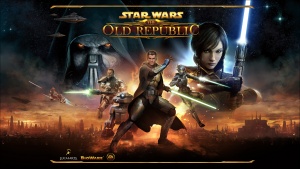Difference between revisions of "MMORPG"
| Line 16: | Line 16: | ||
== Prominent Examples == | == Prominent Examples == | ||
===== ''Neverwinter Nights'' ===== | ===== ''Neverwinter Nights'' ===== | ||
| − | [[File:OldNN.jpg|thumb|''Neverwinter Nights'', 1991]] | + | [[File:OldNN.jpg|thumb|''Neverwinter Nights'', 1991 [http://www.w5d.org/wp-content/uploads/2013/09/neverwinter-nights-1991-h1n-net.jpg]]] |
===== ''Star Wars: The Old Republic'' ===== | ===== ''Star Wars: The Old Republic'' ===== | ||
Revision as of 21:56, 6 April 2014
Overview
A MMORPG (massively multiplayer online role playing game) is a game in which players from all over the world take control of unique (often self-designed) avatars in an online gameworld. Games in this genre frequently take place in fantasy or sci-fi settings much like other Action/Adventure games. MMORPGs, like other role-playing games, are what Simon Egenfeldt Nielsen et al. might call "process-oriented games:" instead of giving the player one, ultimate objective, the game offers a system with which the player can endlessly interact [1]. For example, in World of Warcraft, a player may complete a quest-line in an area in the game, but might continue to slay monsters for the sake of leveling up or saving up for a new item. In MMORPGs, then, there is no ultimate goal beyond what the player prescribes for him or herself.
MMORPGs share many elements with other kinds of role-playing games, including but not limited to setting, character creation, and quests. Narrative is usually incorporated in to MMORPGs through quests, tasks that the player can complete in order to gain a reward, whether that reward be in-game currency, experience points to improve the character's abilities, or items. In MMORPGs where there is a main storyline for the player to follow, quests might be linked together to form a long narrative; however, these "main quests" are often accompanied by "side quests:" shorter, optional narrative units that are not essential for progression in the game. In this way, the narrative of MMORPGs are non-unilinear, a term videogame scholar Sebastian Domsch uses to describe narratives that the player can shape by choosing the order in which (or whether or not) they complete quests [2]. Though non-unilinear narratives are not unique to MMORPGs, they allow the player flexibility in choosing how much he or she wants to participate in "processes" offered by the system of the game.
The flexibility the non-unilinear narratives in MMORPGs' gameworlds allows for players to engage in quests individually or in groups; indeed, the way in which MMORPGs allow a large number of players to coexist in a gameworld together via a server is what sets them apart from other kinds of videogame RPGs (see Action RPG and JRPG). Players might band together temporarily in "parties" to defeat certain enemies that might be too strong for an individual to overcome. In other MMORPGs players can also join "guilds" (sometimes known as "clans," "kinships," or "crews") which function to bring players with similar goals in contact with one another [3]. In this way, MMORPGs offer a variety of social options which can help the player achieve his or her desired experience.
History
The ancestor of all MMORPGs as we know them today is the pen-and-paper role-playing game, Dungeons & Dragons. Commercially released in 1974, D&D capitalized on the popularity of the fictional world of J.R.R. Tolkien's The Lord of the Rings trilogy. D&D originally allowed players to choose between four races (human, hobbit, dwarf, and elf) as well as between three classes (wizard, warrior, and cleric)[1]. Furthermore, D&D required a "dungeon master" to use the game's rules in order to create adventures for other players to experience. As D&D became popular, similar pen-and-paper role-playing games began to emerge using similar frameworks by which players could both create and verbally enact adventures.
The popularity of D&D and other pen-and-paper role playing games gave rise to computer text adventures based in similar fantasy settings like Colossal Cave Adventure (1976) and Zork (1980)[1]. When these single-player text adventures became similarly popular, others began to create multi-user dungeons (or MUDs), which allowed for several players to access a server and experience text adventures at the same time. For example in the first MUD (referred to as MUD1), players could make changes in the gameworld that other players could register. Players could chat with one another and, in some MUDs, even engage in player versus player combat [4].
As technology improved, companies began to produce what were first known as graphical MUDs, and later, the earliest MMORPGs. In 1991, Stormfront Studios released Neverwinter Nights, the first MUD to incorporate graphics [5]. The game was available through AOL in the years 1991 through 1997. Neverwinter Nights spurred the creation of other graphical MUD in the 1990s, including the popular 1997 release of Ultima Online. Ultima Online operated on a ten-dollar per month subscription fee, making it a predecessor to today's popular subscription-based games. In its first year Ultima Online gained over 100,000 subscribers, demonstrating the growing commercial potential of massive multiplayer online worlds.
--WoW
Prominent Examples
Neverwinter Nights

Star Wars: The Old Republic
Star Wars: The Old Republic (or SWTOR), was released in 2011 as was the fastest growing MMORPG of all time, accruing 1 million subscribers only three days after its launch mid-December [6].
World of Warcraft
Significance and Criticism
--popularity
--social elements and pop culture significance (Felicia Day's The Guild)
--Everybody hates grinding
--Women and online gaming? (maybe?) (do I want to open this can of worms?)
References
- ↑ 1.0 1.1 1.2 Understanding Video Games, Simon Egenfeldt-Nielsen, Jonas H. Smith, Susana P. Tosca
- ↑ Storyplaying, Sebastian Domsch
- ↑ How MMORPGs Work
- ↑ MUD
- ↑ Neverwinter Nights (MMORPG)
- ↑ Star Wars: The Old Republic Jumps to Light Speed

